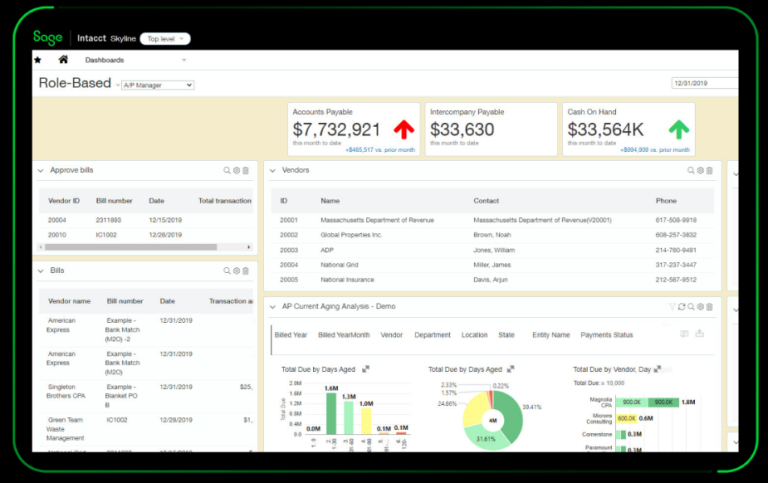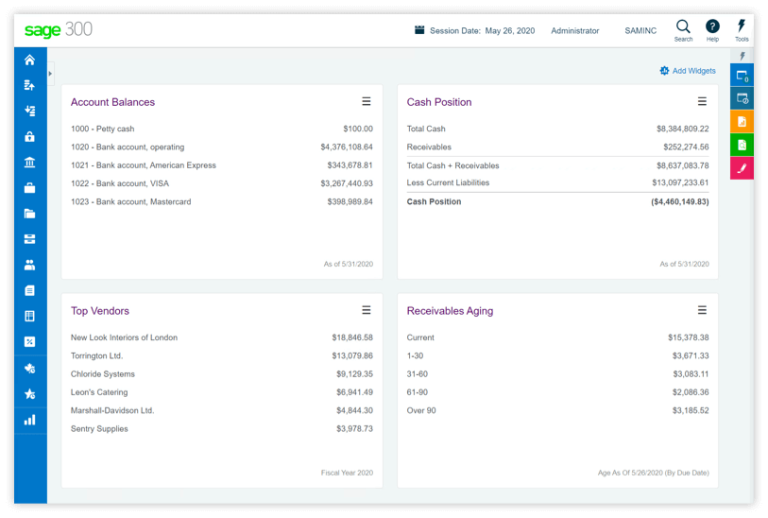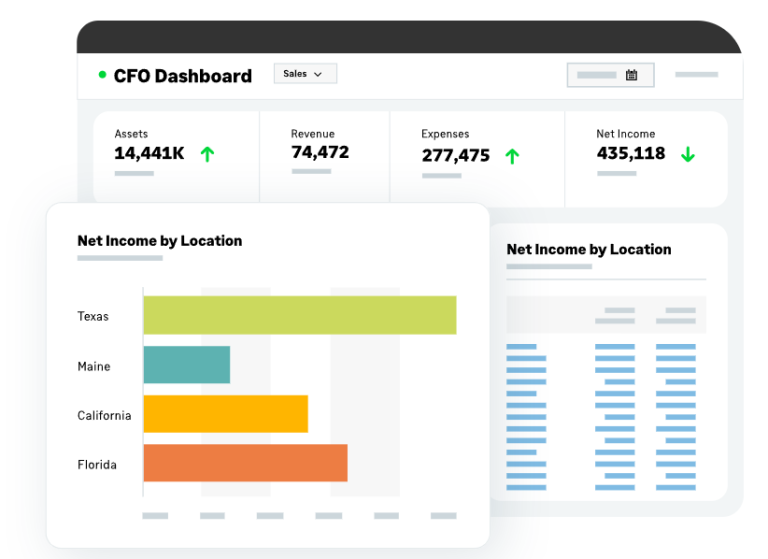As a business thrives and expands, its accounting needs inevitably become more complex. Legacy accounting systems, while familiar, often struggle to keep pace with the demands of a growing organization. These limitations can manifest in several ways.
Firstly, legacy systems often lack integration between departments, leading to data silos and the need for manual data entry. This redundancy increases the risk of errors and inefficiencies.
Secondly, outdated software may not be equipped to handle the growing volume of transactions and data associated with business growth, resulting in performance issues and hindering future expansion.
Finally, legacy systems often provide outdated financial data, making it difficult for businesses to make informed decisions based on real-time performance metrics.
To overcome these challenges and unlock the full potential of their growth, businesses need to consider modern Enterprise Resource Planning (ERP) solutions.
Here’s where Sage Intacct and Sage 300 come in.
Sage Intacct and Sage 300 are powerful ERP solutions designed to empower businesses of all sizes, including small and medium-sized enterprises (SMEs). They offer a comprehensive suite of features for core financials, automation, reporting, and more. By transitioning from a legacy system to Sage Intacct or Sage 300, businesses can streamline operations, gain valuable financial insights, and achieve sustained success.
This blog will serve as a guide for businesses contemplating this transition. Let’s look at the key considerations for choosing the right Sage solution, the essential steps involved in the process, and the significant benefits businesses can expect.
Understanding Your Needs: Choosing the Right Sage Solution

Selecting the optimal Sage solution hinges on comprehending your specific business requirements. Here, we’ll differentiate between Sage Intacct and Sage 300, highlighting their strengths and ideal use cases.
Sage Intacct: A Cloud-Native Powerhouse for Growth
Designed for the cloud from the ground up, Sage Intacct offers a robust and scalable solution for businesses experiencing rapid expansion. Its key strengths include:
- Real-time Financial Visibility: Gain instant insights into your financial health with up-to-date data and robust reporting capabilities.
- Global Operations Support: Manage complex, multi-entity, and multi-currency operations with ease.
- Scalability and Agility: Seamlessly adapt to changing business needs with a highly scalable platform that readily accommodates growth.
- Streamlined Automation: Automate routine tasks like accounts payable and receivable processing to improve efficiency and reduce errors.
Sage Intacct is ideally suited for:
- Fast-Growing Businesses: Sage Intacct caters to companies experiencing significant growth and requiring a solution that can keep pace.
- International Operations: Businesses with multi-national operations benefit from Sage Intacct’s multi-currency and multi-entity capabilities.
- Real-Time Insights Seekers: Companies prioritizing real-time financial data and insights for informed decision-making find Sage Intacct.
Sage 300: A Comprehensive ERP for Flexibility and Control
Sage 300 offers a powerful and versatile ERP solution that is available in both on-premise and cloud deployment options. This flexibility allows businesses to choose the deployment model that best aligns with their infrastructure and security preferences. Sage 300 excels in:
- In-Depth Inventory Management: Businesses with complex inventory needs benefit from Sage 300’s robust inventory management features, including multi-location tracking and serialized inventory control.
- On-Premise Deployment Option: For companies with specific IT infrastructure requirements or security concerns, Sage 300’s on-premise deployment option provides greater control.
- Industry-Specific Solutions: Sage 300offers a variety of industry-specific add-on modules that cater to the unique needs of different verticals.
Sage 300 is a compelling choice for:
- Mid-Sized Businesses with Complex Inventory: Businesses managing complex inventory scenarios find Sage 300’s features well-suited to their needs.
- On-Premise Deployment Preference: Companies seeking an on-premise solution for control and security reasons can leverage Sage 300’s on-premise deployment option.
- Industry-Specific Requirements: Businesses in specific industries can benefit from the industry-specific add-on modules available for Sage 300.
Choosing the Right Fit
Beyond the solution options, several factors influence your selection:
- Business Size and Complexity: The size and complexity of your organization will influence the level of functionality required.
- Deployment Preferences: Consider if a cloud-based or on-premise solution aligns better with your IT infrastructure and security needs.
- Scalability Needs: Choose a solution that accommodates your anticipated growth without requiring frequent upgrades.
- Existing Software Integrations: Ensure the chosen solution integrates seamlessly with your existing business-critical applications.
- Industry-Specific Requirements: Investigate if industry-specific functionalities are available for your chosen solution.
Choosing the right Sage solution is a critical decision that can significantly impact your business operations. Consulting with a qualified Sage Implementation Partner like Microsys is highly recommended to ensure you make an informed selection.
Our certified Sage consultants in Toronto possess the expertise to assess your needs, recommend the most suitable Sage solution, and guide you through a smooth and successful implementation.
Feel free to reach out to us for a free consultation to discuss your requirements and explore how Sage Intacct or Sage 300 can empower your business growth.

Preparing for the Transition: A Roadmap to Success
Transitioning from a legacy system to a modern Sage ERP solution can be a transformative experience for your business. However, meticulous planning and execution are essential to ensure a smooth and successful migration.
Let’s explore the key steps involved and the importance of a well-defined transition plan.
Crafting a Strategic Roadmap
A well-defined transition plan serves as the roadmap for your migration journey. It outlines the key steps, timelines, and resources required for a successful implementation. This plan should encompass:
- Project Scope: Clearly define the functionalities and modules of the chosen Sage solution to be implemented.
- Data Migration Strategy: Establish a strategy for migrating historical data from your legacy system to Sage Intacct or Sage 300.
- System Configuration: Plan for configuring the chosen solution to align with your specific business processes and workflows.
- User Training and Change Management: Develop a comprehensive training plan to ensure users are comfortable with the new system and implement strategies to minimize disruptions and promote user adoption.
- Testing and Go-Live: Define a rigorous testing process to ensure data accuracy and system functionality before transitioning to the new system.
Key Steps for a Seamless Transition:
- Data Migration: Data is the lifeblood of your financial operations. A critical step involves migrating your historical data from the legacy system to your chosen Sage solution. Here, data cleansing and preparation are vital. This may involve identifying and correcting any inconsistencies or errors in your existing data to ensure smooth integration into the new system.
- System Configuration: Once the data migration is complete, your Sage Implementation Partner will configure the chosen solution to meet your specific needs. This includes customizing workflows, setting up user permissions, and integrating with existing business-critical applications.
- User Training: Investing in comprehensive user training is essential for a successful transition. Your Sage Implementation Partner will typically provide training tailored to user roles and responsibilities, ensuring users can effectively leverage the new system’s functionalities.
- Change Management: Implementing a new ERP system can introduce change to existing processes. A well-defined change management strategy helps mitigate any disruptions and fosters user adoption. This may involve open communication with employees, addressing user concerns, and providing ongoing support throughout the transition.
Partnering for a Smooth Journey
A Sage Implementation Partner like Microsys brings invaluable expertise to the transition process. Our team of certified Sage consultants has extensive experience guiding businesses through successful ERP implementations. They can assist with:
- Developing a comprehensive transition plan.
- Data migration and cleansing.
- System configuration and customization.
- User training and change management.
- Testing and go-live support.
By leveraging the expertise of a Sage Implementation Partner, you can ensure a smooth and efficient transition, minimizing disruptions and maximizing the return on investment in your new Sage ERP solution.

Key Considerations for Transition Success: Building a Strong Foundation
A successful transition to a Sage ERP solution hinges on several key considerations that go beyond the technical aspects. Here, we’ll explore these crucial elements to ensure a smooth onboarding experience and maximize user adoption.
Clear Communication: The Cornerstone of Success
Maintaining open and transparent communication throughout the transition process is paramount. This includes:
- Regular project updates: Keep all stakeholders informed on the progress of the implementation, including project milestones and potential challenges.
- Open communication channels: Encourage open communication where users can voice questions and concerns, fostering a collaborative environment.
- Transparency about expectations: Clearly communicate the functionalities and limitations of the new system, managing user expectations and ensuring a smooth learning curve.
Managing User Expectations: Setting the Stage for Adoption
A critical aspect of successful user adoption involves effectively managing expectations. Here’s how:
- Focus on the benefits: Highlight the advantages of the new system, such as increased efficiency, improved data accuracy, and real-time insights.
- Address concerns proactively: Identify and address potential user concerns regarding the transition and the new system’s functionalities.
- Tailored training: Provide user training tailored to specific roles and responsibilities, ensuring users gain the necessary skills to leverage the system effectively.
Rigorous Testing and Data Validation: Confidence Before Go-Live
Before transitioning to the new system, comprehensive testing is essential. This involves:
- System functionality testing: Thoroughly test all functionalities of the Sage solution to ensure they operate as expected.
- Data validation: Verify the accuracy and completeness of migrated data to ensure smooth operations and reliable reporting.
- User acceptance testing: Allow users to test the system and provide feedback to identify and address any usability issues before going live.
Building Long-Term Success: Ongoing Support is Key
The transition doesn’t end with the system going live. Ongoing support is crucial for ensuring user proficiency and addressing any challenges that may arise:
- Post-implementation support: Your Sage Implementation Partner can provide ongoing support to address user questions, troubleshoot issues, and offer guidance on maximizing system utilization.
- Knowledge base and resources: Provide users with access to a comprehensive knowledge base and resources to facilitate self-learning and address common questions.
- Continuous training: Offer ongoing training opportunities to keep users updated on new features and functionalities of the Sage solution.
You can create a solid foundation for a successful transition to your new Sage ERP solution by prioritizing these key considerations. With clear communication, managed expectations, rigorous testing, and ongoing support, you can ensure user adoption and maximize the value you derive from your investment.

The Benefits of Transitioning to Sage Intacct or Sage 300
Transitioning to a modern Sage ERP solution empowers your business to operate at a new level of efficiency and control. Here are some key advantages you can expect to gain:
Enhanced Financial Management and Control:
- Automate routine accounting tasks like accounts payable and receivable processing, freeing up valuable staff time.
- Eliminate manual data entry and reduce errors with seamless data integration across departments.
- Improve operational efficiency and achieve faster close cycles.
Empowered Business Intelligence and Real-Time Insights:
- Leverage powerful reporting tools to gain real-time visibility into key performance indicators (KPIs).
- Analyze trends, identify opportunities, and make data-driven decisions to optimize business performance.
- Stay informed with up-to-date financial data to manage cash flow and resources proactively.
Increased Scalability and Flexibility to Support Future Growth:
- Sage solutions are designed to scale seamlessly with your business, accommodating growth without requiring frequent upgrades.
- Benefit from a flexible platform that adapts to your evolving business needs and integrates with future technologies.
- Future-proof your operations and ensure your financial systems can support your long-term growth aspirations.
Improved Collaboration and Communication:
- Foster better communication and collaboration across departments with a centralized platform for financial data.
- Enhance transparency and accountability with real-time access to financial information for authorized users.
- Streamline communication and decision-making processes with a unified system for financial management.
Additional Benefits:
Depending on the chosen Sage solution, you may unlock further advantages:
- Sage Intacct: Real-time global consolidation capabilities streamline financial management for multi-national businesses.
- Sage 300: Industry-specific functionalities cater to the unique needs of various industry verticals.
By transitioning to a Sage ERP solution, you equip your business with the tools and capabilities to thrive in today’s dynamic market. Improved financial control, real-time insights, and enhanced operational efficiency empower you to make informed decisions, optimize performance, and achieve sustainable growth.
Investing in Your Future
As your business expands, a modern Sage ERP solution becomes essential for maintaining financial control, streamlining operations, and gaining valuable insights. By transitioning to Sage Intacct or Sage 300, you unlock a wealth of benefits that empower informed decision-making, optimize performance, and propel your business toward sustained growth.
Choosing the right Sage solution and partnering with a trusted Sage Implementation Partner like Microsys is is critical for a successful transition. Our team of certified Sage consultants possesses the expertise to guide you through every step of the process, ensuring a smooth and efficient migration.

Ready To Unlock the Power of Sage for Your Business?
Get in touch with Microsys at (416) 425 0444 for a free consultation. We’ll discuss your specific needs, identify the most suitable Sage ERP solution (Sage Intacct or Sage 300), and explore how our comprehensive suite of services can empower your success.
We’re not only a Sage Implementation Partner but also a Managed IT Services Provider offering Cyber Security Services and HRMS – Human Resource Management System solutions and more.
Let our team of experts, conveniently located across the Greater Toronto Area (GTA), including Markham, Stouffville, Richmond Hill, Ajax, Ottawa, North York, Newmarket, and Aurora, help you navigate your business transformation journey and achieve your full potential.



